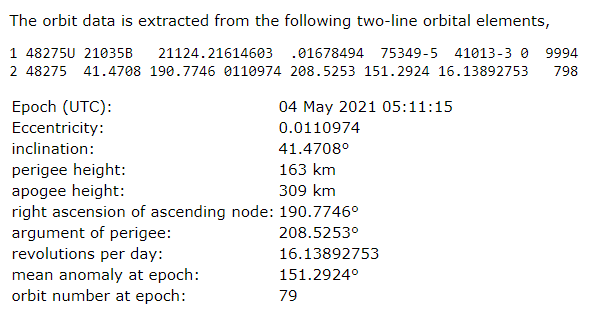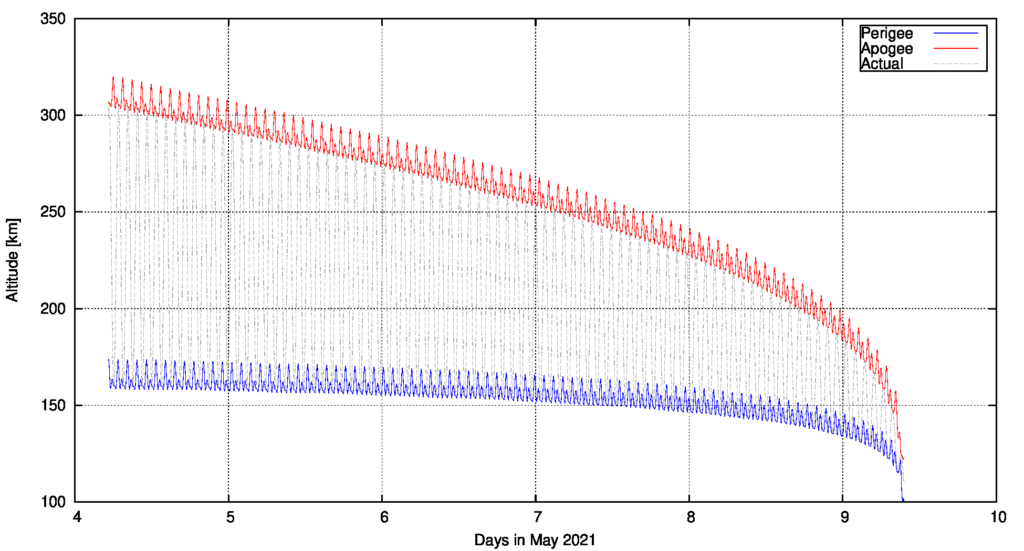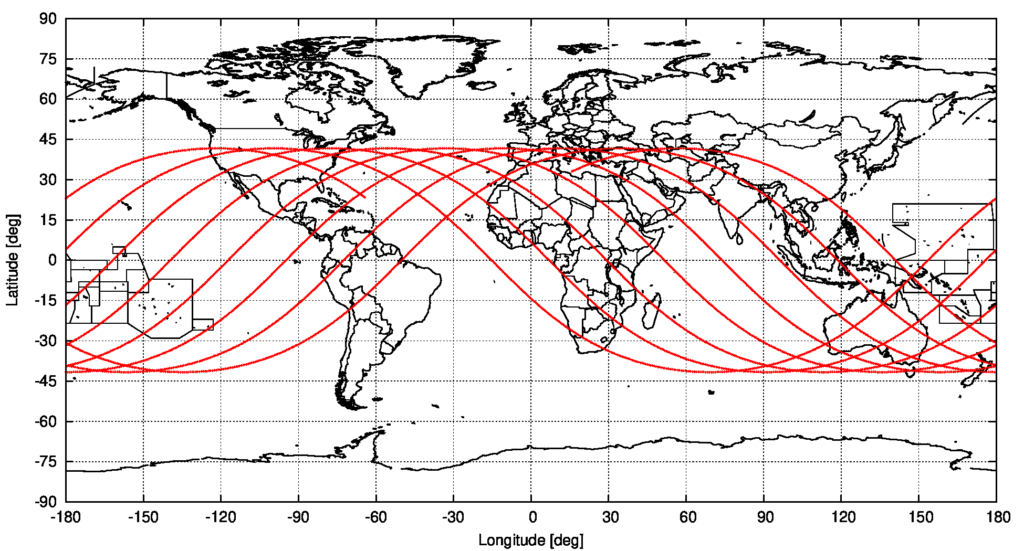The Reentry of Long March 5B

On 29 April 2021, a Long March 5B heavy lift launch vehicle lifted into orbit Tianhe, the first module of the new large modular Chinese space station Tiangong. The Long March 5B vehicle consists of a core stage and four boosters. While the boosters go into a suborbital trajectory and never reach a stable orbit, the core stage initially was in the same orbit as that of its payload.
Core stages of rockets normally cannot be restarted, so they cannot perform any more manoeuvres once they have shut down their main engine (the SpaceX Falcon 9 is an exception). This means that the Long March 5B core stage couldn’t do a safe deorbiting manoeuvre so it would fall safely into the SPOUA (South Pacific Ocean Uninhabited Area).
Orbit Decay
The launch orbit was rather low. Its lowest point (its perigee) was about 185 km above the ground, its highest point (apogee) about 380 km. An object in such a low orbit is subject to considerable atmospheric drag. Drag forces act most strongly around the perigee, because the lower the altitude, the higher the density. The effect of this is that the apogee decreases faster than the perigee does. It may appear counter-intuitive, but that’s the way it is.
But the perigee also decreases, so the drag keeps on increasing. Drag removes energy from the orbit – in the end the object will be so low that it no longer manages a complete orbit, It will then enter a steep decline. When it encounters dense atmosphere layers it will be like hitting a brick wall – it will be ripped to pieces and much of it will burn up due to friction.
For a small object, that’s it. End of the matter. But the core stage of a heavy lift rocket is not a small object. What’s more, a rocket stage contains some parts that are designed to withstand high temperatures. So when a rocket stage re-enters, debris might reach the ground.
So there is some concern about the core stage of the Long March 5B. The problem is that it is impossible to predict exactly when and where re-entry will happen until very shortly before it happens.
What we know
Objects in space are tracked by radar, and the radar data are used to determine the orbit. The measurements and the calculations are repeated regularly, so we know where the object is and we also know how its orbit has been changing. The Long March 5B core stage has received a unique COSPAR ID: 2021-035-B. You can use that to find the latest orbit determination results. I got mine from heavens-above.com.

Jonathan McDowell tweeted a diagram that shows the evolution of the orbits of Tianhe and the Long March 5B core stage from launch until the morning of 4 May 2021. This was very useful because now comes the hard part.
What we want to know
Predictions are particularly difficult if they pertain to future events. Often the only option is to look at past events and try to learn things from them that can then be used to compute the future evolution.
Let me tell you right away that I am not privy to any restricted information. I am using only publicly available data and some educated guesses – pretty much what anyone else could do.
The simplest approach is straightforward extrapolation. I could look at Jonathan’s diagram and simply extend the lines for apogee and perigee to the right. But that is certain to give me a wrong result because the curves increasingly angle downwards. That’s because the atmospheric density and with it the drag forces increase sharply, the more the orbit decays.
It is much better to perform a numerical simulation of the orbit, using a computer to compute the forces acting on the stage. I know the orbital elements at a given time. That’s a good start. I also have a fairly reliable model of the atmospheric density. And there, the problems start – the density does not depend only on the altitude, but also on how active the sun is. If the solar activity, especially at extreme UV wavelengths, suddenly increases, then that will churn up the upper atmosphere and significantly increase the air density there.
I don’t know whether that will happen at all. But if it does, it would have an effect on the re-entry time and location – it could advance it by half a day or more.
Another thing I don’t know is how the rocket stage is oriented with respect to the flow. The Long March 5B core stage looks roughly like a cylinder with a height of 33 metres and a diametre of 5 metres. So the cross section it presents to the flow could be anywhere between 20 and 166 square metres. I’m assuming the stage is tumbling, so I just assume that the mean cross section is in the middle between those two values … around 93 square metres.
This is where Jonathan McDowell’s diagram is handy because it gives me hard data from the past. If I plug a mean cross section of 93 square metres into my orbit propagation tool, and the empty mass of 21.6 metric tons, then the evolution of the orbit that my software computes turns out to be very similar to what has been observed over the past days. It seems as if my approach isn’t all wrong then.
So here is my prediction

Right. So here is what I obtain. The horizontal axis doesn’t show a nice date scale, but it should be clear what is meant. Suffice it to stay that the axis starts on 2021/5/4 00:00 UTC and counts in days, so it covers a total of six days, ending 2021/5/10 00:00 UTC. The curves start at 05:11:15, as I showed above.
So if the sun continues to behave as it did the past days, we’d be looking at re-entry on Sunday, 9 May 2021 09:27 UTC according to what my results tell me. Other sources predict re-entry at somewhat earlier times (9 May 2021 04:37 UTC +/- 28 h or 9 May 2021 00:34 UTC +/- 28h) We’ll just have to wait and see.
But again, and I can’t say this often enough, these computations are fraught with uncertainties! Please keep this in mind.
Re-entry could happen many hours earlier or later and therefore at a very different location. There is no way to tell right now. But it wouldn’t be correct to say that the Long March 5B core stage can come down just about anywhere.
Firstly, the inclination of the orbit is around 41.5 degrees. So re-entry and any debris impact can only happen between 41.5 deg northern and southern latitude. Any places farther to the north than 41.5 deg N and further to the south than 41.5 deg S are safe.
Secondly, re-entry can only happen along the ground track, not far off it. Here I show the ground track for the final 12 hours of the trajectory I computed.

You see that – as always, those latitudes close to the highest and lowest overflown latitude value are the most exposed. Here – and I now tell you for the third time that this is no more than a rough prediction – the final twelve-hour ground track starts over the Mediterranean and ends in the West Atlantic. Should re-entry happen during the early hours of Sunday, UTC, the above ground track gives an indication of places where it might happen. If Long March 5B remains in orbit longer, then there will be more ground tracks added to the left of what is shown here.
Stay tuned!


Yes and Tianhe‘s perigree is 351 km and its apogee is 385 km according to Heavens Above. Quite low, lower than the typical ISS-orbit, but perhaps the station gets a boost or gets fuel from Tianzhou-2 which will visit it on 20 May 2021.
The Tianhe orbit is probably not the same as the launch orbit of Long March 5B because as I guess, Tianhe has also a propulsion module, which was activated just after orbit insertion.
Indeed Tianhe must be able to adjust its orbit by means of an onboard propulsion unit. This can be seen in the diagram tweeted by Jonathan McDowell which I linked in my article. Tianhe’s perigee is raised shortly after separation, first to 290 km, then to 350 km.
During the construction phase, the ISS was operated at a lower orbit than it is now. This allowed a larger payload mass for the Shuttle and Proton flights that were bringing up hardware. The completed station was raised to an operational altitude of around 400 km after the Shuttle was retired.
This photo of Tianhe and the Long March 5B core stage clearly proves that the stage is tumbling with a high frequency – which significantly simplifies the assumptions to be made for the effective aerodynamic cross section.
I’ve been watching the orbital data closely lasy week. Looks like your graph was spot-on! Any updates?
Spot on or not, we will only know that after the stage will have re-entered in the coming night. 🙂 The updates are –> here
Hi, nice analysis! Could you comment on why both the perigee and apogee show alternating high and low peaks for every orbit? Or should these curves only be looked at when it touches the curve of the actual height?
You are right. The perigee and apogee values given here are the osculating values; they change throughout the orbit as semi-major axis and eccentricity undergo short-periodic variations. Either one looks at the actual altitude or I should have provided the mean apo- and perigee.
By the way, the “altitudes” are not actually the true altitude above the current location on the geoid, but given with respect to the equatorial radius of the Earth. I did that to maintain consistency with just about everyone else, who are all using the same convention.
Thanks, but what causes those oscillations? Influence of the moon, the fact that the earth is not a perfect sphere, …?
The latter. Mostly the Earth oblateness. That’s why these osculating parameters show such strong variation over one orbital period